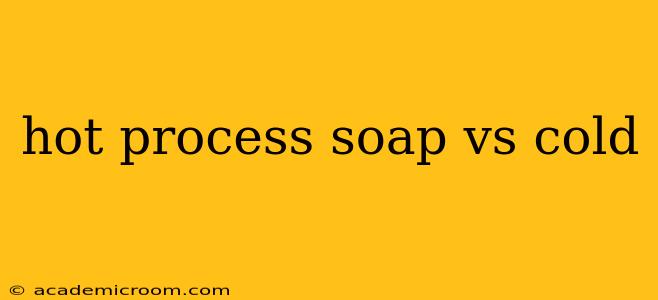Making soap is a rewarding craft, but understanding the differences between hot process and cold process soapmaking is crucial for achieving your desired results. Both methods produce soap, but they differ significantly in their processes, resulting in variations in the final product. This comprehensive guide will delve into the key distinctions, helping you choose the best method for your needs.
What is Cold Process Soapmaking?
Cold process soapmaking is the traditional method, known for its simplicity and the ability to create beautiful, richly colored soaps with intricate designs. It involves combining oils and lye (sodium hydroxide) in a careful, measured process. The chemical reaction, called saponification, generates heat, but the mixture is not actively heated. Instead, it's poured into a mold and left to cure for several weeks. During this curing process, excess water evaporates, and the soap hardens, becoming milder and longer-lasting.
Advantages of Cold Process Soapmaking:
- More design flexibility: Allows for intricate designs, swirls, and color variations.
- Superfatting options: Allows for intentional superfatting (leaving behind excess oils), resulting in a more moisturizing bar.
- Natural ingredients: Easily incorporates natural additives like herbs, clays, and essential oils.
- Longer shelf life (after curing): The curing process creates a more stable and long-lasting bar.
Disadvantages of Cold Process Soapmaking:
- Longer curing time: Requires several weeks of curing before use.
- Requires precise measurements: Inaccurate measurements can result in unusable soap.
- Potential for lye burns (if not handled carefully): Always wear appropriate safety gear.
What is Hot Process Soapmaking?
Hot process soapmaking accelerates the saponification process by applying external heat. The mixture is heated, typically in a double boiler or crockpot, until it reaches a specific consistency, often resembling pudding. This significantly reduces the curing time compared to cold process.
Advantages of Hot Process Soapmaking:
- Faster process: Soap is ready to use much sooner than cold process soap.
- No curing time needed (mostly): Though a short period of drying might improve the bar's hardness, it's generally usable immediately.
- Easier for beginners (arguably): The process is less demanding in terms of precise timing and temperature control.
- Less chance of accidental lye burns (with proper handling): The heat helps to accelerate the saponification process and neutralize the lye more quickly.
Disadvantages of Hot Process Soapmaking:
- Less design flexibility: The heating process limits the creation of intricate designs.
- Can be more difficult to achieve consistent results: Overheating can negatively impact the final product.
- May have a slightly less smooth texture: The heating process can result in a slightly less smooth or creamy texture compared to cold process.
- Potential for scorching: If not monitored carefully, the soap can scorch, ruining the batch.
Hot Process vs. Cold Process: Which is Better?
The "better" method depends entirely on your preferences and goals.
- Choose cold process if: You prioritize design flexibility, a long shelf life, and enjoy a more involved crafting process.
- Choose hot process if: You value speed, simplicity, and a quicker turnaround for your soapmaking efforts.
Frequently Asked Questions
Is hot process soap as good as cold process soap?
Both methods produce soap that effectively cleanses. The main differences lie in the process, timeline, and potential design variations. Cold-processed soap often has a smoother texture and might be considered "better" by some due to the longer curing time. However, hot process soap is perfectly functional and provides a faster result.
Which soapmaking method is easier for beginners?
Many beginners find hot process soapmaking easier due to its shorter processing time and less critical need for precise temperature control. However, both methods require careful attention to safety precautions.
Can I add essential oils to hot process soap?
Yes, essential oils can be added to hot process soap, but it's crucial to add them toward the end of the process to avoid losing their fragrance due to the heat.
What is the shelf life of hot process soap?
Hot process soap has a good shelf life, but it is advisable to store it in a cool, dry place to maintain its quality and prevent it from drying out. While it’s usable immediately, allowing it to dry for a few days after making can improve its hardness.
Does hot process soap require a longer curing time?
No, the significant advantage of hot process soapmaking is the drastically reduced curing time. It's typically usable immediately, although a short period of drying might be beneficial for hardening. This is in contrast to cold-process soap, which requires several weeks of curing.
This comprehensive comparison of hot process and cold process soapmaking should provide you with the knowledge to select the method best suited to your skills and preferences. Remember always to prioritize safety when working with lye. Happy soapmaking!
